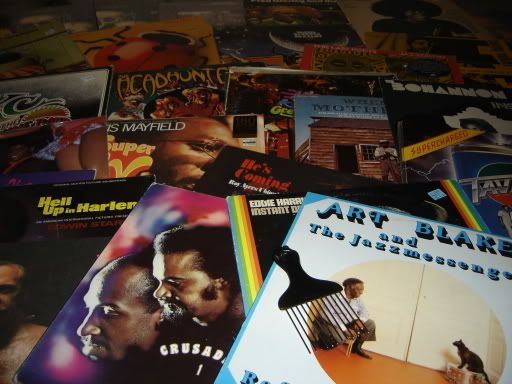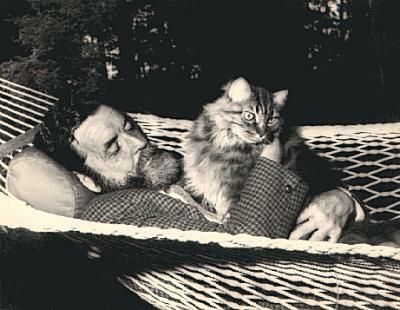 This week in poetry class, we learned about one of my favorite poets, Etheridge Knight. One of the main reasons I really love his poetry is because even though he dropped out of school at such a young age (16, in fact) he was still a poetic genius. He was born in Corinth, Mississippi, in 1931, and was given honors from the Guggenheim Foundation, the National Endowment for the Arts, and the Poetry Society of America.
This week in poetry class, we learned about one of my favorite poets, Etheridge Knight. One of the main reasons I really love his poetry is because even though he dropped out of school at such a young age (16, in fact) he was still a poetic genius. He was born in Corinth, Mississippi, in 1931, and was given honors from the Guggenheim Foundation, the National Endowment for the Arts, and the Poetry Society of America.Luckily, we got to read my favorite poem by Knight, "The Idea of Ancestry," in class this week. The poem itself reads:
1
Taped to the wall of my cell are 47 pictures: 47 black
faces: my father, mother, grandmothers (1 dead), grand-
fathers (both dead), brothers, sisters, uncles, aunts,
cousins (1st and 2nd), nieces, and nephews. They stare
across the space at me sprawling on my bunk. I know
their dark eyes, they know mine. I know their style,
 they know mine. I am all of them, they are all of me;
they know mine. I am all of them, they are all of me;they are farmers, I am a thief, I am me, they are thee.
I have at one time or another been in love with my mother,
1 grandmother, 2 sisters, 2 aunts (1 went to the asylum),
and 5 cousins. I am now in love with a 7-yr-old niece
(she sends me letters in large block print, and
her picture is the only one that smiles at me).
I have the same name as 1 grandfather, 3 cousins, 3 nephews,
and 1 uncle. The uncle disappeared when he was 15, just took
off and caught a freight (they say). He's discussed each year
when the family has a reunion, he causes uneasiness in
the clan, he is an empty space. My father's mother, who is 93
and who keeps the Family Bible with everbody's birth dates
(and death dates) in it, always mentions him. There is no
place in her Bible for "whereabouts unknown."
2
Each fall the graves of my grandfathers call me, the brown
hills and red gullies of mississippi send out their electric
messages, galvanizing my genes. Last yr/like a salmon quitting
the cold ocean-leaping and bucking up his birth stream/I
hitchhiked my way from LA with 16 caps in my pocket and a
monkey on my back. And I almost kicked it with the kinfolks.
I walked barefooted in my grandmother's backyard/I smelled the
old
land and the woods/I sipped cornwhiskey from fruit jars with the
men/
I flirted with the women/I had a ball till the caps ran out
and my habit came down. That night I looked at my grandmother
and split/my guts were screaming for junk/but I was almost
contented/I had almost caught up with me.
(The next day in Memphis I cracked a croaker's crib for a fix.)
This yr there is a gray stone wall damming my stream, and when
the falling leaves stir my genes, I pace my cell or flop on my bunk
and stare at 47 black faces across the space. I am all of them,
they are all of me, I am me, they are thee, and I have no children
to float in the space between.
Overall, in the first section of the poem, Knight is describing a setting where he is sitting in his jail cell staring at all of these pictures of his relatives on the wall. He looks at these pictures very often, and he reminds himself that no matter how successful a person if with or without the help of their families, they still are a part of the family. He even comments on one of his uncles, whose “whereabouts [are] unknown"; regardless of whether the uncle wants to admit it or not, he is part of the family and there is nothing that can change that fact.
In the second section of the poem, Knight describes his reckless behaviors from when he was young; these events were probably the culmination of him going to jail. In one night he manages to “walk barefooted in my grandmother’s backyard/ smell the old land and the woods/ sip cornwhiskey from fruit jars with the men / flirt with women.” After all of these actions were done, he was forced to see his grandmother, and he was full of aberration and shame, he could not even face her.
By the end of the poem, he reiterates the idea of families joining together constantly. Not only does
this poem reach out to individual families, but Knight was also trying to reach out to the African American community at large. Larry Neal, a famous poetry critic, said in response to this poem that, "Black Arts is the aesthetic and spiritual sister of the Black Power concept. As such, it envisions art that speaks directly to the needs and aspirations of Black America." Knight supports the Black Arts movement throughout the poem, because he describes his family, as well as the African American family as “dead . . . living . . . [and] unborn,” recognizing that he still has commitments to his family. Finally, he also addresses the Black Arts Movement and his family at the end of the poem by assuring to both of them, "[he is] all of them / they are all of [him], [he is himself], they are thee.
 This concept of continuity between African Americans during this period is what really led to having an African American flourishing community. Many other poets too followed this avenue, and ultimately, African Americans benefitted tremendously. Another prime example is Gwendolyn Brooks. In her poem "We Real Cool," overall she wanted to persuade people to stay in school, and think before a person (specifically an African American) acts. During the Early and Middle Twentieth century, there was a lot of crime and depression in urban areas across the United States. In order not to starve, many adults and teenagers hit the streets in order to make any money they could. Keeping this in mind, Brooks is trying to forward to her readers that although it may be satisfying and fun at the moment to be reckless and miss out on school, education is the most important part of any young man or lady's life. Through all of these positive messages sent to the upcoming generations, African Americans began speaking out and saying, "'We, the people'is a very eloquent beginning. But when that document [the Preamble to the US Constitution] was completed on the seventeenth of September in 1787 I was not included in that 'We, the people.' I felt somehow for many years that George Washington and Alexander Hamilton, just left me out by mistake. But through the process of amendment, interpretation and court decision I was finally included in 'We, the people.'"[Barbara C. Jordan 1974].
This concept of continuity between African Americans during this period is what really led to having an African American flourishing community. Many other poets too followed this avenue, and ultimately, African Americans benefitted tremendously. Another prime example is Gwendolyn Brooks. In her poem "We Real Cool," overall she wanted to persuade people to stay in school, and think before a person (specifically an African American) acts. During the Early and Middle Twentieth century, there was a lot of crime and depression in urban areas across the United States. In order not to starve, many adults and teenagers hit the streets in order to make any money they could. Keeping this in mind, Brooks is trying to forward to her readers that although it may be satisfying and fun at the moment to be reckless and miss out on school, education is the most important part of any young man or lady's life. Through all of these positive messages sent to the upcoming generations, African Americans began speaking out and saying, "'We, the people'is a very eloquent beginning. But when that document [the Preamble to the US Constitution] was completed on the seventeenth of September in 1787 I was not included in that 'We, the people.' I felt somehow for many years that George Washington and Alexander Hamilton, just left me out by mistake. But through the process of amendment, interpretation and court decision I was finally included in 'We, the people.'"[Barbara C. Jordan 1974]. If it were not for the Black Arts Movement, and scores of poets preaching positive messages to stay together and peacefully protest to gain equality among all men and women, who knows what the United States of America would be like today.






 It seems like the Harlem Neighborhood looks totally different right now from the pictures and the articles I read, but I still want to visit there. Most of the buildings might disappeared already, but the Harlem Renaissance is memorized in people's hearts.
It seems like the Harlem Neighborhood looks totally different right now from the pictures and the articles I read, but I still want to visit there. Most of the buildings might disappeared already, but the Harlem Renaissance is memorized in people's hearts.







